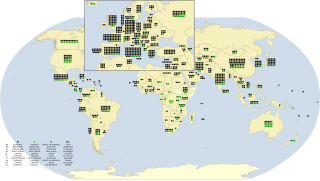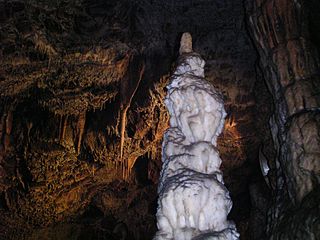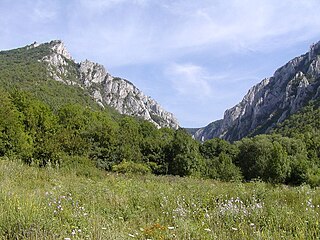
The Slovak Karst is one of the mountain ranges of the Slovenské Rudohorie Mountains in the Carpathians in southern Slovakia. It consists of a complex of huge karst plains and plateaus. Since 1973 it has been a protected landscape area. On 1 March 2002 Slovak Karst National Park was declared. It is also a UNESCO Biosphere Reserve and part of it forms UNESCO World Heritage site Caves of Aggtelek Karst and Slovak Karst.

The Slovak Ore Mountains are an extensive mountain range within the Carpathian Mountains, located mostly in Slovakia's Spiš and Gemer region, with a small part in northern Hungary. It is the largest mountain range in Slovakia. Geomorphologically, the Slovak Ore Mountains belong to the Inner Western Carpathians.

As of January 2023, there are a total of 1,157 World Heritage Sites located across 167 countries, of which 900 are cultural, 218 are natural and 39 are mixed properties. The countries have been divided by the World Heritage Committee into five geographic zones: Africa, Arab States, Asia and the Pacific, Europe and North America, and Latin America and the Caribbean. With 58 selected areas, Italy is the country with the most sites on the list.

Aggtelek National Park is a national park in Northern Hungary, in the Aggtelek Karst region. The most significant values of the national park are the special surface formations and caves in this limestone landscape.

The North Hungarian Mountains, sometimes also referred to as the Northeast Hungarian Mountains, Northeast Mountains, North Hungarian Highlands, North Hungarian Mid-Mountains or North Hungarian Range, is the northern, mountainous part of Hungary. It forms a geographical unity with the Mátra-Slanec Area, the adjacent parts of Slovakia. It is a separate geomorphological area within the Western Carpathians.

Ochtinská Aragonite Cave is a unique aragonite cave situated in southern Slovakia, near Rožňava. Although only 300 m long, it is famous for its rare aragonite formations. Along with other caves of the Slovak Karst, it is included in the UNESCO World Heritage list as a component of Caves of Aggtelek Karst and Slovak Karst site, because of its diversity of aragonite formations and testimony to the cave-forming geologic processes.

Dobšiná Ice Cave is an ice cave in Slovakia, near the mining town of Dobšiná in the Slovak Paradise. Since 2000 it has been included on the UNESCO World Heritage list as a part of the Caves of Aggtelek Karst and Slovak Karst site, because of its unique cave formations and its natural beauty.

The Domica cave is a karst cave situated on the south-western border of the Silicka planina Plateau 10 km (6.2 mi) south-east of Plesivec in the Rožňava District of the Košice Region in southern Slovakia. In combination with the Baradla cave, it makes up the most significant section of the Aggtelek Karst and Slovak Karst cross-border cave network that continues into the Aggtelek National Park in Hungary. The cave is well-known for its complex structure and high density of speleothems.

Jasov Cave is a speleothem limestone cave and archaeological site in the Slovak Karst in Slovakia. It is located near the village of Jasov, around 25 km (16 mi) from Košice city. Along with a number of caves of the Slovak Karst, Jasov Cave has been induced into the UNESCO World Heritage list as a part of the Caves of Aggtelek Karst and Slovak Karst site, because of its unique diversity of speleothems and its testimony to tropical and temperate cave-forming processes. The cave is known for its pagoda-like stalagmites, sinter waterfalls, and straw stalactites.

Slovak Karst National Park is a national park in the Slovak Karst mountain range in South East Slovakia. It lies in the Gelnica, Rožňava and Košice–okolie districts in the Košice region. The National Park covers an area of 346.11 km² (133.64 mi²) and its buffer zone covers 117.41 km² (45.33 mi²).

Aggtelek is a village in the county of Borsod-Abaúj-Zemplén, Hungary. It is known for the vast stalactite caverns of the nearby Baradla-Domica cave system, part of the UNESCO World Heritage Site of Aggtelek and Slovak Karst.

The Caves of Aggtelek Karst and Slovak Karst are a series of over 1000 karst caves spread out over a total area of 55,800 ha along the border of Hungary and Slovakia. With an exceptional diversity of karst structures and complex cave systems developing from both temperate and tropical processes, the caves and surrounding areas were inscribed as a UNESCO World Heritage site in 1995.
Krásnohorská Cave is a karst cave situated at the northern foot of the Silická planina Plain, in the Slovak Karst, 6.5 km southeast of Rožňava, in Slovakia. With unique natural decorations of bizarre shapes and unusual structure composed almost entirely of calcium, it is currently listed by the Guinness Book of Records as the cave containing the largest stalagmite in existence, generally accepted as being about 12 metres (39 ft) in diameter and 32.7 metres (107 ft) in height. It grows significantly in volume every year as the incessant drips solidify.

The Three Natural Bridges are a series of natural limestone bridges located in Xiannüshan Town, Wulong District, Chongqing Municipality, China. They lie within the Wulong Karst National Geology Park, itself a part of the South China Karst-Wulong Karst UNESCO World Heritage Site. In Chinese, the bridges are all named after dragons, namely Tianlong Qinglong and Heilong.

Aggtelek Karst is a karst area in northern Hungary.

The Baradla Domica cave system is a large cave system in northern Hungary. As part of the Aggtelek Karst, it extends more than 25.5 km (25,500 m) and includes the 5.3 km (3.3 mi) Domica cave. A significant part of the cave has varied colors and shapes providing an unparalleled spectacle of decorative stalactites.



















